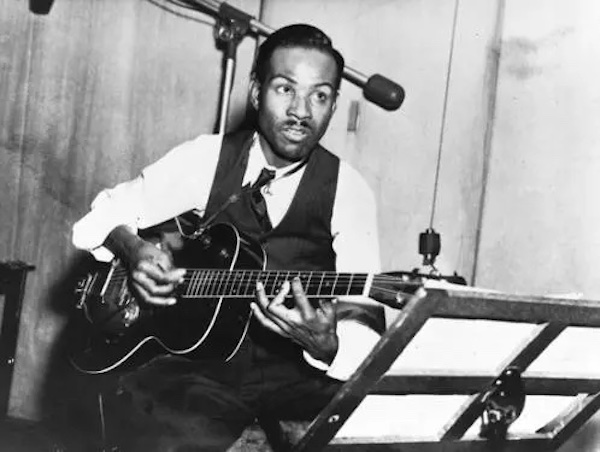Film Review: The Swing Jazz of Eddie Durham — Credit Well Deserved
By Steve Provizer
I may not agree with some of the documentary’s spin, but the film gives the viewer a clear and entertaining picture of Eddie Durham’s long and important musical career.
WHAM Re-Bop-Boom-Bam: The Swing Jazz of Eddie Durham, produced and directed by WVIA’s Kris Hendrickson and Executive Producer Ben Payavis. Premiering on February 1 on PBS stations. Check out when the documentary is screening in your area.
Jazz is thought of by many as strictly improvisational music, but arrangements are an important part of the music. In small groups, arrangements are often an afterthought, but can be used to great effect. In larger ensembles, arrangements are, in fact, the foundation of a performance, whether the tune is a ballad, medium tempo, or a flag waver. I’ve always felt that jazz arrangers are not given the credit they deserve. There are a few reasons why. In the trade, arranging was considered piece work, worth only so much per arrangement. Bandleaders (and agents and performers) often took credit for tunes — and arrangements. And, aside from the product of staff writers working up stock arrangements (“stocks”) for publishers, the paper trail is incomplete or has been lost.
Arranger/composer/musician Eddie Durham is among the most important of that unsung group and this documentary should help give him the credit he deserves.
Durham grew up in rural Texas, the son of a sharecropper/ cowboy/fiddler. He quickly acquired the skills to thrive in a competitive musical environment, touring with circus and minstrel troupes (Black and white acts traveled and lived together) and with his own family in the Durham Brothers Orchestra.
In the late ’20s Durham landed in Kansas City, not a bad place for a jazz musician. He was hired to play trombone and guitar and write arrangements for the top bands in that town, Walter Page Blue Devils and the Bennie Moten Orchestra. He modernized Moten’s sound. Then, when Count Basie took over Moten’s group, Durham’s work became fundamental to Basie’s sound. Basie’s “book” was composed largely of head arrangements — riffs and melodies made up at rehearsals or on the gig. Durham took those arrangements and created music that was flexible but solidly structured. Still, I’m not certain that I’d go as far as the doc does and give Durham sole credit for creating the “Kansas City sound,” which emphasized call-and-response between sections and creative use of riffing. Arrangers like Jessie Stone and Joe Garland were also active and influential.
The picture of jazz arranging in the ’20s-’30s was complicated, and it may have been beyond the scope of this film to clarify it. However, it would have helped the viewer to understand Durham’s arranging niche if the film had at least tried to put his work in the context of previous arrangers, such as Fud Livingston, Don Redman, Bill Challis, Benny Carter, and Fletcher and Horace Henderson. That said, there is no doubt that Durham was a key figure. He is quoted in later years as saying he “was helping to stabilize some things that were all mixed up.”

Guitarist, trombonist, and arranger Eddie Durham — a key figure in jazz history.
After he moved to Jimmie Lunceford’s band in the mid-’30s, Durham wrote and arranged hits for them, including “WHAM Rebop, Boom, Bam,” “Avalon,” “Lunceford Special” and “Hittin’ the Bottle. He was also partially responsible for the dazzling choreography developed by the band. Again, the film may be exaggerating some about Durham’s contribution to Lunceford’s sound, which was also shaped by the work of Sy Oliver and Eddie Wilcox.
Like most arrangers, Durham freelanced with other bands, including those of Benny Goodman, Artie Shaw, and Glenn Miller. He contributed to the arrangement of Miller’s biggest swing hit “In the Mood,” and in 1941 fashioned a hit for the Ink Spots with his arrangement of “I Don’t Want to Set the World on Fire”.
Apart from his writing skills, Durham was an excellent trombonist and was in the vanguard of the use of electric guitar in jazz. A mentor to Charlie Christian, he was a bit of an inventor, coming up with early versions of electric guitars. Durham showed how the instrument could be used in a jazz context as a member of a rhythm section and as a solo instrument. He showcased his skills in some well-known sessions he put together called the Kansas City Five and Six using members of the Basie band in 1938.
There was a second and a third act for Durham, In the ’40s, when many male musicians were in the armed services, Durham became associated with several female bands on the rise, including the “International Sweethearts of Rhythm.” In the ’50s-’60s, he continued to arrange for various bands. Then, in the ’70s, he formed the Harlem Blues and Jazz Band with Albert Vollmer. In his seventies and eighties, he toured with that band all over the U.S. and Europe.
There are a number of talking heads in the film, including several of Durham’s children and musicians like Vincent Gardner of Jazz at Lincoln Center and musician-educator Loren Schoenberg, who spent time playing with Durham. We see Schoenberg conduct a class at Juilliard playing Durham charts — it’s satisfying to see young performers recognize the value of his music.
This is a sweet movie, and that seems to reflect the temperament of its subject. Durham didn’t drink or smoke and was clearly a pretty unflappable guy. I may not agree with some of the film’s spin, but WHAM Re-Bop-Boom-Bam gives the viewer a clear and entertaining picture of Durham’s long and important musical career. As a kind of coda in the film, we see a park and a festival being dedicated to the musician in his hometown — honors well deserved.
Steve Provizer writes on a range of subjects, most often the arts. He is a musician and blogs about jazz here.
